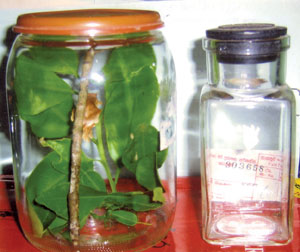Home breeding of butterflies
by K.G.H. Munidasa
Breeding butterflies at home is really the most useful method of
studying their life cycle. Professional breeders may use cages, mosquito
netting etc for the purpose.
But, in my experience, breeding butterflies in bottles affords better
chances of quietly studying them.
I have been breeding butterflies in bottles for the past thirty years
or so, at various times, and so far I may have kept over one hundred
larvae of various species.
 |
|
Breeding bottle (left)
and hatching bottle. |
For this purpose I keep two types of bottles, i.e. a small one with a
rubber stopper for the hatching of eggs and a larger (round, with a four
inch mouth) for larvae.
The former is square shaped with flat sides so that the ova (eggs)
may be examined without removing the rubber stopper. Once the larvae is
hatched it is transferred to the large bottle, which is equipped with a
plastic lid that can be fitted tightly over the mouth.
I have found that empty jam or marmalade bottles are handy for the
smaller species of butterflies, provided they are fitted with plastic
lids. However, for larger species like the Swallow tails, large bottles
will have to be used.
In my experience bottles are preferable to cages in that (a) the cut
leaves remain fresh longer and (b) larvae cannot wander away and can be
studied more closely than they in a cage.
However, precautions must be taken to see that the bottle is
spotlessly clean, and water sprinkled over the larvae daily.
The stopper should be removed at least once a day to admit fresh air
into the bottle. Needless to say, a small magnifying glass will be
helpful in observing details, whenever necessary.
The larvae must never be picked up or handled in any way. In
supplying fresh leaves the larvae must be allowed to transfer to a new
leaf by itself. Several times during the course of growth the larvae
sheds its skin and for many hours before this it prefers to rest on a
carpet of silk of its own making, on the wall of the bottle or in a
similar place. At this stage the larvae must not be disturbed in any
manner.
When the time comes round for pupation proper provision has to be
made according to the species. A label showing the date of hatching,
pupation and the expected date of emergence of the adult insect should
be affixed to the bottle for future reference.
The adult butterfly is not capable of flight as soon as it emerges
from the pupal case. In course of time the pupa (chrysalis) turns
brownish or blackish, when the wing pattern of the (Imago) full-grown
butterfly begins to appear in the transparent fore-wing bud on the front
underside.
Thereafter, the head section of the pupa splits open and the matured
butterfly creeps out.
It will remain there long enough to enable the blood to pass on
through the vein system of the wings causing to enable the blood to pass
on through the vein system of the wings causing them to expand to their
full, which soon dry up.
This process takes between 30 to 45 minutes, before the adult
butterfly becomes active and flies away.
It is advisable to watch the procedure closely and release it from
the bottle preferably to a cluster of leaves in the open air.
|

